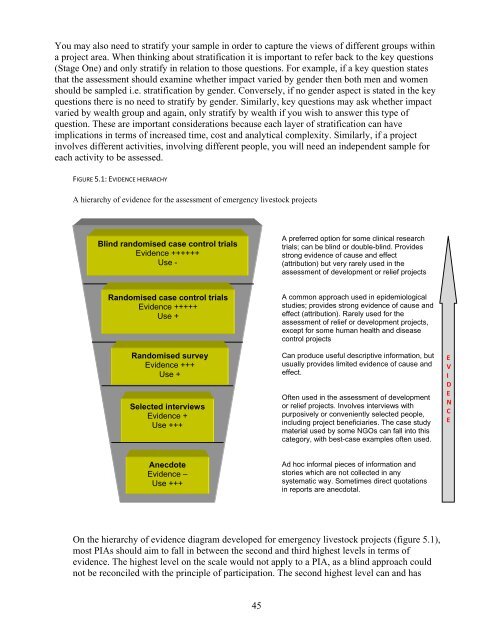Participatory Impact Assessment - Capacity4Dev
Participatory Impact Assessment - Capacity4Dev
Participatory Impact Assessment - Capacity4Dev
You also want an ePaper? Increase the reach of your titles
YUMPU automatically turns print PDFs into web optimized ePapers that Google loves.
You may also need to stratify your sample in order to capture the views of different groups within<br />
a project area. When thinking about stratification it is important to refer back to the key questions<br />
(Stage One) and only stratify in relation to those questions. For example, if a key question states<br />
that the assessment should examine whether impact varied by gender then both men and women<br />
should be sampled i.e. stratification by gender. Conversely, if no gender aspect is stated in the key<br />
questions there is no need to stratify by gender. Similarly, key questions may ask whether impact<br />
varied by wealth group and again, only stratify by wealth if you wish to answer this type of<br />
question. These are important considerations because each layer of stratification can have<br />
implications in terms of increased time, cost and analytical complexity. Similarly, if a project<br />
involves different activities, involving different people, you will need an independent sample for<br />
each activity to be assessed.<br />
FIGURE5.1:EVIDENCEHIERARCHY<br />
A hierarchy of evidence for the assessment of emergency livestock projects<br />
Blind randomised case control trials<br />
Evidence ++++++<br />
Use -<br />
A preferred option for some clinical research<br />
trials; can be blind or double-blind. Provides<br />
strong evidence of cause and effect<br />
(attribution) but very rarely used in the<br />
assessment of development or relief projects<br />
Randomised case control trials<br />
Evidence +++++<br />
Use +<br />
Randomised survey<br />
Evidence +++<br />
Use +<br />
Selected interviews<br />
Evidence +<br />
Use +++<br />
A common approach used in epidemiological<br />
studies; provides strong evidence of cause and<br />
effect (attribution). Rarely used for the<br />
assessment of relief or development projects,<br />
except for some human health and disease<br />
control projects<br />
Can produce useful descriptive information, but<br />
usually provides limited evidence of cause and<br />
effect.<br />
Often used in the assessment of development<br />
or relief projects. Involves interviews with<br />
purposively or conveniently selected people,<br />
including project beneficiaries. The case study<br />
material used by some NGOs can fall into this<br />
category, with best-case examples often used.<br />
E<br />
V<br />
I<br />
D<br />
E<br />
N<br />
C<br />
E<br />
Anecdote<br />
Evidence –<br />
Use +++<br />
Ad hoc informal pieces of information and<br />
stories which are not collected in any<br />
systematic way. Sometimes direct quotations<br />
in reports are anecdotal.<br />
On the hierarchy of evidence diagram developed for emergency livestock projects (figure 5.1),<br />
most PIAs should aim to fall in between the second and third highest levels in terms of<br />
evidence. The highest level on the scale would not apply to a PIA, as a blind approach could<br />
not be reconciled with the principle of participation. The second highest level can and has<br />
45

















